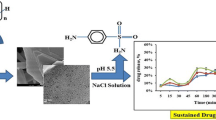Abstract
Ten commercially available calcium phosphates used for direct tableting were evaluated. The particle size distributions, powder properties, Sorption isotherms and pH values of aqueous slurries were compared. All samples showed good or at least sufficient flowability. Scanning electron micrographs illustrated the different kinds of manufacturing and gave hints on their expectable behaviour under compaction pressure. The sorption isotherms of identical chemical substances, which had been manufactured by different methods, differed strongly. This can be related to their specific surface areas. Most of the hydroxylapatites have large surface areas and can absorb up to more than 15% water at 93% relative humidity. Dibasic calcium phosphate dihydrate was non-hygroscopic and absorbed less than 1% water. With the exception of monobasic calcium phosphate monohydrate all calcium phosphates behaved quite neutral in water. Monobasic calcium phosphate monohydrate can be regarded as a solid acid. Although the calcium phosphates are usually stable substances, the role of crystal water in the case of dibasic calcium phosphate dihydrate and monobasic calcium phosphate monohydrate is problematic due to possible interactions with active ingredients.
Similar content being viewed by others
References
Toy ADF, Walsh EN. Phosphorous chemistry in everyday living. 2nd ed. Washington: Americal Chemical Society, 1987.
Carstensen JT, Erteil C. Physical and chemical properties of calcium phosphates for solid state pharmaceutical formulations. Drug Dev Ind Pharm 1990;16(7):1121–33.
Carstensen JT, Ertell C. Physical and chemical properties of calcium phosphates for solid state pharmaceutical formulations. In: Proceedings of the 5th International Congress on Pharmaceutical Technology. Chatenay-Malabry: Association de Pharmacie Galenique Industrielle, 1989:306–14.
Carstensen JT. Drug stability: principles and practices. 1st ed. New York: Marcel Dekker, 1990:193–203.
Bartholomé E, Biekert E, Hellman H, Ley H, Weigert WM. Ullmanns Encyklopädie der technischen Chemie. 4th ed. Weinheim: Verlag Chemie 1979:333–4.
Weast RC, Astle MJ, Beyer WH, eds. CRC Handbook of chemistry and physics. 64th ed. Boca Raton: CRC Press, 1983.
Gmelins Handbuch der anorganischen Chemie. 8th ed. Vol. Calcium, Part B/3. Weinheim: Verlag Chemie, 1961.
Roberts WL, Campbell TJ. Encyclopedia of minerals. 2nd ed. New York: Van Nostrand Reinhold Company, 1990.
Nebelung A, Vogt M. Über die Eigenschaften von Calciumphosphaten im Hinblick auf ihre Verwendung in der Biokeramik. Sprechsaal 1986;119(12):1131–4.
Dany F-J. Zahnpastenputzkörperphosphate — ihre Prüfung und Anwendung. Seifen Oele Fette Wachse 1978;104(11):305–10.
Klüppel H-J, Plöger W, Förg F, Umbach W. Parameters for assessing the cleaning power of toothpastes. J Soc Cosmet Chem 1986;37:211–23.
Hedge RP, Rheingold JL, Welch S, Rhodes CT. Studies of powder flow using a recording powder flowmeter and measurement of the dynamic angle of repose. J Pharm Sci 1985;74(1):11–5.
De Haan P, Kroon C, Sam AP. Decomposition and stabilization of the tablet excipient calcium hydrogenphosphate dihydrate. Drug Dev Ind Pharm 1990;16(13):2031–55.
Rabach H. Verfügbarkeit des Wassers in Hilfsstoffen für die Hydrolyse eines Wirkstoff-Models in Tabletten [dissertation]. Hamburg: Universität Hamburg, 1980:150–63.
El-Shattawy HH, Peck GE, Kildsig DO. Aspartame — direct compression excipients: preformulation stability screening using differential scanning calorimetry. Drug Dev Ind Pharm 1981;7(5):605–19.
El-Shattawy HH. Ampicillin — direct compression excipients: preformulation stability screening using differential scanning calorimetry. Drug Dev Ind Pharm 1982;8(6):819–31.
El-Shattawy HH, Kildsig DO, Peck GE. Cephalexin1 — direct compression excipients: preformulation stability screening using differential scanning calorimetry. Drug Dev Ind Pharm 1982;8(6):897–909.
El-Shattawy HH, Kildsig DO, Peck GE. Erythromycin — direct compression excipients: preformulation stability screening using differential scanning calorimetry. Drug Dev Ind Pharm 1982;8(6):937–47.
Chrzanowski FA, Ulissi LA, Fregely BJ, Newman AC. Preformulation excipient compatibility testing. Application of a differential scanning calorimetric method versus a wet granulation simulating, isothermal stress method. Drug Dev Ind Pharm 1986;12(6):783–800.
Zwecker M. Bewertung und Zusammenfassung von Zielgrößen bei der Tablettenentwicklung mit der modifizierten Simplex-Methode am Beispiel von Multivitamin-Supplement-Präparaten [dissertation]. Marburg: Philipps-Universität Marburg, 1989.
Author information
Authors and Affiliations
Rights and permissions
About this article
Cite this article
Schmidt, P.C., Herzog, R. Calcium phosphates in pharmaceutical tableting. Pharm World Sci 15, 105–115 (1993). https://doi.org/10.1007/BF02113938
Accepted:
Issue Date:
DOI: https://doi.org/10.1007/BF02113938



